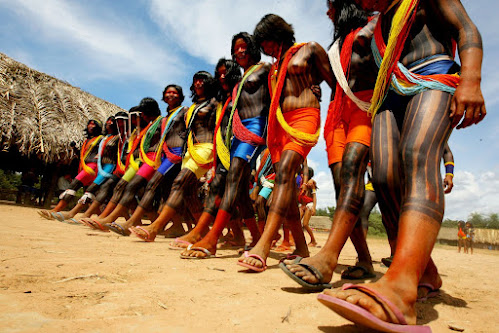Mythologies of the Terena Tribes
The Terena people are an indigenous people of Brazil. Their traditional language is Terena. They live in the states of Mato Grosso, Mato Grosso do Sul, and São Paulo. With the establishment of the Serviço de Proteção aos Índios in 1910, the definite allocation of Indian lands shortly afterwards, and the location of a government Indian Post near Taunay in 1916, the Terena people were placed under a reservation-like system. On 15 May 2013, a group of hundreds of Terena re-occupied a parcel of land, now owned by a local politician and rancher, that they believe is part of their Indigenous ancestral territory. The Buriti farm is in the Sidrolândia municipality. After two weeks of occupation, they were forcibly evicted on 30 May by local police. One of their members, 35-year-old Osiel Gabriel, was shot and killed by police during the eviction, and three others were injured. The Terena managed to regain control of the land on 1 June.
With a population of approximately 13 thousand people, the Terena, an Arawak-speaking people, presently live in a discontinuous territory, fragmented into small “islands” surrounded by ranches and scattered over six municipalities of Mato Grosso do Sul – Miranda, Aquidauana, Anastácio, Dois Irmãos do Buriti, Sidrolândia, Nioaque and Rochedo. There are also Terena families living in Porto Murtinho (Kadiweu Indigenous Land), Dourados (Guarani Indigenous Land) and in the state of São Paulo (TI "Araribá" Indigenous Land). In the last two places mentioned, Terena families were taken there during the administration of the Indian Protection Service (SPI) to serve as an “example” for the local Indians (an example of diligence in agriculture and also of “obedience” to the control system imposed by the employees of the agency). The present-day Terena indigenous reserves were “requested” from the state of Mato Grosso by the SPI in the 1920s and ‘30s; two of them, however, (Cachoeirinha and Taunay/Ipegue) were “granted” by the state government at the beginning of the century. The total Terena population in the state of Mato Grosso do Sul is around 16,000 people. Of this total, 13,629 still live on the indigenous lands cited above, or around 2,400 families.
The Terena tribe from Mato Grosso do Sul and Sao Paulo, Brazil, are determined to gain legal right to their ancestral lands – ones that were taken from them in 1928 and given to cattle farmers. The Terena tribe lays claim to about 17,000 hectares of land, but were forced to live on a reservation of only 2,000 hectares, which a community member, Alberto, has stated is too small for his community. In 1988, the Brazilian constitution was amended to include a provision that called for the return of ancestral lands to indigenous peoples in an effort to compensate for a long history of discrimination, violence and slavery. But, now, it is 20 years past the deadline to return these lands and traditional populations are still displaced. In 2013, the indigenous people from the district of Taunay began protesting and demanding that the government take a position regarding their land ownership. About 80 tribe members occupied a 4,800 hectare ranch called Esperança (‘hope’ in English). Men, women and children participated in this protest, which demanded that the property residents leave within 24 hours. [2] These protests turned violent and one member of the tribe was killed. Shortly thereafter, different villages started to invade local farms, demanding to get their land back.
The Terena tribes are an indigenous community in Brazil with a rich history and deep-rooted cultural heritage. Residing mainly in the state of Mato Grosso do Sul, the Terena have maintained their ancestral traditions, spiritual beliefs, and sustainable practices for generations. This article delves into the history, culture, social structure, economic activities, challenges, and the significance of preserving the Terena tribes as custodians of indigenous knowledge and cultural heritage amidst the modern-day complexities. The Terena tribes have inhabited the Mato Grosso do Sul region in Brazil for centuries, making them one of the oldest indigenous communities in the country. Their historical roots can be traced back to pre-Columbian times when they lived as semi-nomadic hunter-gatherers and practiced shifting cultivation. The Terena tribes hold a rich cultural heritage that revolves around their spiritual beliefs and practices. They have a profound connection to the land and the natural world, considering it sacred and central to their existence.
The Terena are a Guana or Chane ("many people" in the Terena language) subgroup that originally lived in the northeast of the Paraguayan Chaco. At present the Terena are located almost entirely in the municipalities of Miranda and Aquidauana, in the Brazilian state of Mato Grosso do Sul, except for a small group living in villages in the state of Sao Paulo. The Aquidauana-Miranda region lies between 20° and 22° S and 54° and 58° W. The elevation of the region is less than 200 meters. The climate is moist-tropical. The Terena are among the few native Brazilian populations that have displayed population growth. In the 1840s, when they migrated into Brazilian territory, the Terena numbered about 3,000. At the end of the 1950s, there were around 3,800. Official data note approximately 12,000 village dwellers during the mid-1980s. Informal estimates suggest that up to 8,000 Terena live on the outskirts of the main towns in Mato Grosso do Sul. Birthrates are high, as are mortality rates. This give the population structure of the Terena an appearance similar to that of the Brazilian population in general—a pyramid with a broad base and a narrow top. Until the 1950s infectious diseases in general and tuberculosis in particular were the main causes of death. Today the causes of death are mixed, with infectious as well as chronic degenerative causes. Among children, the main causes of death are infectious diseases, especially gastroenteritis and respiratory infections.
































Comments
Post a Comment